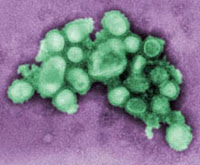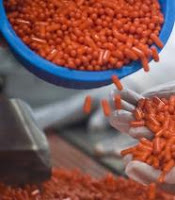A New Hope with a new drug for H1N1 Flu
 Athena Gurno thought her allergies were acting up when she started coughing in early October. But within days, Ms. Gurno, the 30-year-old mother of a young girl, was in a Seattle hospital, close to death from the H1N1 flu.
Athena Gurno thought her allergies were acting up when she started coughing in early October. But within days, Ms. Gurno, the 30-year-old mother of a young girl, was in a Seattle hospital, close to death from the H1N1 flu.Desperate, her doctors tried a still-experimental drug called peramivir. After getting her second dose, Ms. Gurno started to recover, though she is still in intensive care, according to her father, John Spikowski.
“This saved Athena’s life,” Mr. Spikowski reported on a blog that tracks his daughter’s progress.
Peramivir might also be a life saver for its developer, BioCryst Pharmaceuticals, an unprofitable biotechnology company in Birmingham, Ala., that was founded in 1986 but has not yet had a drug reach the market.
On Thursday, the federal government ordered, on an emergency basis, 10,000 treatment courses of peramivir for its national stockpile. It is paying $22.5 million, or about $2,250 a patient. Shares of BioCryst rose nearly 13 percent, to $11.39.
Peramivir is given intravenously, making it usable by hospitalized patients who are too ill to take two approved flu drugs that work against the virus in similar ways — Tamiflu by Roche, which is typically given as a pill, or Relenza from GlaxoSmithKline, which is inhaled.
Late Thursday, the government announced orders for intravenous versions of Tamiflu and Relenza, which are much cheaper — a development that could force shares of BioCryst to give up some of their gains on Friday.
Peramivir, still being tested in clinical trials, is not approved by the Food and Drug Administration for general use. But on Oct. 23, the F.D.A. granted authority for the drug to be used in emergencies for patients hospitalized with H1N1 flu who cannot take or do not benefit from Tamiflu or Relenza.
Before that, peramivir had been available only through a more cumbersome “compassionate use” procedure. Of the 32 patients who received the drug that way, 29 were still alive, BioCryst said in late October.
Although there are still questions about peramivir’s true effectiveness, some critics say the government moved too slowly to make the drug available, and that even now, access is too restricted. For each patient, doctors must call an 800 number or fill out a form on a Web site run by the Centers for Disease Control and Prevention. The drug is then sent overnight from a central stockpile.
“If you have a critically ill patient, to delay therapy, it’s just incomprehensible to me,” said Dr. Richard Whitley, a professor at the University of Alabama and the president of the Infectious Diseases Society of America. He said the drug should be distributed so that hospitals could have it in stock.
But Dr. Nicole Lurie, assistant secretary for preparedness and response at the Department of Health and Human Services, said the limited supplies made more general distribution impossible. Some doctors said they were satisfied with the existing system.
“I think it’s fairly accessible,” said Dr. Thomas M. File Jr., chief of infectious diseases at Summa Health System in Akron, Ohio, who has treated a pregnant woman with peramivir. Some of the push to make the drug more widely available is coming from investors in BioCryst, including Kleiner Perkins Caufield & Byers, the prominent Silicon Valley venture capital firm. John Doerr, the company’s technology guru, was in Washington this week making the case for greater availability of peramivir, according to a person who met with him there.
Other investors — both supporters of BioCryst stock and those betting the price will fall — have commented at government meetings on flu preparations, often without revealing their financial interests.
Anecdotes like Ms. Gurno’s aside, the efficacy of peramivir is still in question, according to the government. While some clinical trials showed the drug had an effect in resolving flu symptoms, others did not show statistically significant differences between peramivir and either a placebo or Tamiflu.
The question for both investors and federal authorities is how much more of the drug BioCryst can sell. So far, the order has been far less than some investors had hoped, though the price of the order announced Thursday was higher than expected.
Dr. Lurie, the federal official, said there had been 237 requests to use the drug since the emergency use authorization was granted nearly two weeks ago. Many doctors want to provide the treatment for 10 days instead of the recommended 5, she said, so the 10,000 courses the government ordered might actually treat as few as 5,000 patients.
The government has the right to buy up to 30,000 more treatment courses at the same price.
BioCryst says it will have perhaps 40,000 more treatment courses available within a few weeks, and a total of 120,000 by the end of the year. It also says it has signed up partners to try to win sales in Brazil, Mexico, Israel and China.
“We’re getting a lot of interest from countries outside the United States,” Jon P. Stonehouse, the company’s chief executive, said in an interview Thursday.
Shionogi, a Japanese drug company with licensing rights from BioCryst, ran its own clinical trials and this week applied for approval to sell the drug in Japan as a treatment for everyday flu, in competition with Tamiflu.
But in the United States, BioCryst plans to try to win approval for treatment only of hospitalized patients. It is now beginning phase 3 trials — the last stage before seeking F.D.A. approval.
Virtually all the money to develop the drug comes from $180 million in grants from the Department of Health and Human Services. Yet the company gets to keep as profit anything it makes from selling the drug to the federal government or to other governments. Mr. Stonehouse defended the price of the drug, saying it would save the health system money by getting patients out of intensive care earlier. “The cost of being in the I.C.U. and on a ventilator is extremely high,” he said.
But peramivir will soon have competition. The federal government said late Thursday that it had also ordered 10,000 treatment courses each of intravenous versions of Tamiflu and Relenza, with options to buy 30,000 more courses of each.
Those drugs could not be used, however, until they received emergency use authorizations from the F.D.A.
The government is paying an average of only $450 a course for those other drugs — only one-fifth of what it is paying for peramivir.
Right now, Dr. Lurie said, peramivir is the only drug that can be used intravenously so the government had to pay a high price. “I would say that one of the things that happens in the market when you have competition is that the price drops.”
read more» Read more...
















